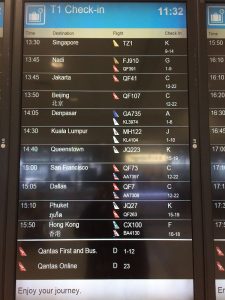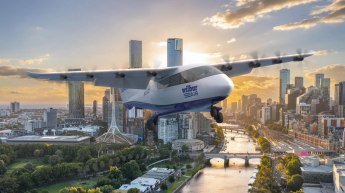
Qantas chief executive Alan Joyce says a lower cost base, the growth in the China market and partnerships with local carriers are the necessary ingredients to ensure the Flying Kangaroo’s return to Beijing will prove more successful than previous attempts to serve the Chinese capital.
The oneworld alliance member resumed nonstop service to Beijing on Wednesday, with QF107 operated by Airbus A330-200 VH-EBG taking off from Sydney Airport just after 1400 local time.
The daily flight is the first time Qantas has flown to Beijing since it dropped the Chinese capital from its route network in 2009.
Joyce says the rapid growth in the outbound Chinese market, coupled with the anticipated boost to commerce between the two nations due to the recently negotiated free trade agreement, means the market dynamics have changed significantly since Qantas ended flights to Beijing eight years ago.
Moreover, Qantas was a very different airline compared with its operations of 2009, particularly following the airline’s cost reduction transformation program.
“Our product is a lot better, our cost base is a lot better than it was in 2009,” Joyce told reporters at Sydney Airport on Wednesday before boarding the inaugural service alongside Qantas international chief executive Gareth Evans.
“So we think the economics, from the demand side, from a business market and from our cost base, are very different now than they were back then.”

Joyce noted Beijing was the 11th biggest route out of Sydney. Qantas already served the top 10 markets.
Qantas’s return to Beijing comes ahead of Virgin Australia’s daily flights to Beijing and Hong Kong that were planned to start on June 1 2017 from a yet-to-be-disclosed Australian city in partnership with Chinese conglomerate HNA.
The Beijing service adds to Qantas’s existing daily flight between Sydney and Shanghai with Airbus A330 equipment, as well as nonstop flights to Hong Kong from Brisbane, Melbourne and Sydney. The Australian carrier also has an alliance with China Eastern and codesharing arrangements with China Southern for beyond points in China, and has recently added extra flights to Hong Kong.
Qantas also has dedicated freighter services into a number of Chinese cities.
“We are very happy to reintroduce services to Beijing,” Joyce said.
“Qantas today has never been bigger in the greater China market. We have more services, more destinations and an amazing partnership that gives us more breadth than we have ever had before.”
Evans noted Qantas was able to do a slot swap with China Eastern to secure more convenient landing and takeoff times for its Beijing flights.

Further, he said the response from the travelling public has been encouraging since the return to Beijing was launched in October.
“The loads on the first flight and the initial period are extremely strong, in the high eighties and above,” Evans said.
“Beyond that, the service is tracking to to the same sorts of seat factors as our Shanghai service, which has been established for a number of years.”
Flight QF107 is scheduled as an afternoon departure from Sydney, landing just at 2240 local time. The reciprocal QF108 is an overnight service from Beijing, touching down in Sydney in the mid-afternoon.
The flight times appear to limit the number of connections beyond Beijing, given the late arrival.
However, the mid-afternoon arrival in Sydney will ensure Chinese tourists visiting Australia will be able to connect to other Australian destinations such as Tasmania, which Joyce said was proving increasingly popular for the Chinese, as well as New Zealand.
“Getting those domestic and trans-Tasman connections is really key,” Joyce said.
“We think Beijing on its own with 21 million people is a big enough destination for it to justify the service in its own right. Through Shanghai and Hong Kong we serve another 23 destinations in China.”
Apart from when scheduling issues arise, the A330-200s that will be deployed to Beijing will be the two unrefurbished A330s in the Qantas fleet, VH-EBG or VH-EBL.
The two Airbus widebodies are yet to be fitted with new Thompson Aero Seating business class seats, an updated economy cabin and new Panasonic inflight entertainment systems throughout the cabin that are already on Qantas’s 10 A330-300s and 16 of 18 A330-200s.
Instead, VH-EBG and VH-EBL have angled lie-flat SkyBeds in business class in a 2-2-2 configuration and previous generation Rockwell Collins seat-back inflight entertainment (IFE). The two aircraft are also fitted with crew rest areas.
Joyce said he expected all of Qantas’s Asian services to feature the new Thompson Aero Seating business class seat at some future point.
“We are working through the reconfigs of those aircraft as we speak,” Joyce said.
“Eventually all of our aircraft flying into the Asian region will have our new product. It is just that at this time they are the two aircraft that have the range to get there.
Asked if having the SkyBeds rather than Thompson Aero seats in business class would put Qantas at a disadvantage compared with other carriers on the route, Joyce said: “We don’t think it gives us a disadvantage, we still think that product is an amazing product.”
China was expected to overtake New Zealand as Australia’s largest inbound tourism market by 2018. About 1.2S million Chinese visited Australia in 2016.
Air China and China Eastern also fly nonstop between Sydney and Beijing.
Flight Number/Routing |
Days of operation |
Time of departure |
Time of arrival |
|
QF107 Sydney-Beijing |
Daily |
13:50 |
22:40 |
|
QF108 Beijing-Sydney |
Mon, Tue, Wed, Fri, Sat |
00:15 |
14:55 |
|
QF108 Beijing-Sydney |
Thu, Sun |
00:20 |
14:55 You need to be a member to post comments. Become a member today!
Comments (5)Comments are closed. You don't have credit card details available. You will be redirected to update payment method page. Click OK to continue. |
















ButFli
says:Why is Qantas letting these two unrefurbished aircraft fester in the fleet?
It’s total BS that they advertise the updated lie-flat business class seating to customers, but may substitute wedgie-inducing unrefurbished aircraft at any time and there is nothing the paying customer can do about it.
In any other industry that would be false advertising.
maplesyrup
says:Good start by QF108, the very first flight back to SYD left Beijing over 3.5 hours late.
David
says:Now that Sydney to Beijing services have commenced, Qantas need to ensure they get enough planes to service routes from Beijing and Shanghei to Melbourne, Brisbane and Perth to capitalise on the Chinese tourism boom.
Marco
says:@David agreed, I really want a Shanghai flight from Melbourne.
Wez
says:@David
We all know that Qantas isn’t going to fly from Perth to Beijing. Virgin is more likely to fly the Aussie Flag from Perth.